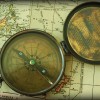How A Compass Works
The compass is one of the oldest navigation tools. It is so old that it’s unclear who is responsible for inventing it, but many believed it originated in China over 2,000 years ago. Today’s advanced technologies like GPS may make compasses seem pointless or obsolete. However, compasses have a major advantage over most of today’s fancy technologies. Because they use natural properties of magnetism to navigate and don’t require electricity or batteries, you don’t have to worry about them losing their navigation capabilities. A compass is one of the most essential survival tools. However, they do have a few limitations like their magnetic variations called magnetic and true north.
Magnetic North vs. True North
The technology of a compass is based on magnets and Earth’s magnetic properties. The main component of a compass is a magnetized needle. The needle will automatically align with Earth’s magnetic north and south poles but over the years travelers discovered that the alignment would vary when traveling east to west. They would compare the magnetic north, the direction at which the needle is pointing, to the true north, the actual geographic location, by looking at the sky and sun for navigation.
Compass Navigation Basics
A compass can prove extremely useful when used properly. When using a compass, you must first know what direction you need to travel. Once that is determined you should take the most common compass bearing stance which is referred to as the center-hold technique. Below are some steps to help orient and navigate from there:
- In this stance, hold the compass flat in your palms and in front of your midsection.
- Move the travel arrow (pointing away from the compass) until it aligns in the direction you have been traveling.
- Line up your orienting lines with the north end of the magnetic needle.
- If not aligned turn your body until the north end of the magnetic needle aligns with the orienting needle. Follow the direction of the travel arrow.
This process is often referred to as “getting your bearings.” You should do it to make sure you are headed in the right direction.
With a compass in hand and a few techniques in mind, you could become a navigation wizard, or at least, navigate your way through the woods or your apartment. For more navigational tips using a compass, map, and triangulation, one of Apex's fans, Connor—from Boy Scouts Lake Jennings Troop 325, found this amazing resource. Thanks, Connor! If you have any compass tips or questions, feel free to leave a comment!

